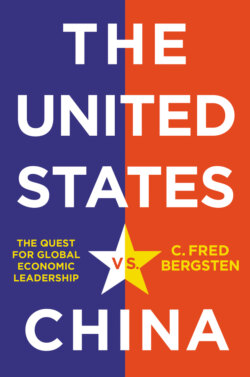The United States vs. China

Реклама. ООО «ЛитРес», ИНН: 7719571260.
Оглавление
C. Fred Bergsten. The United States vs. China
CONTENTS
List of Illustrations
List of Tables
List of Boxes
Guide
Pages
THE UNITED STATES VS. CHINA. The Quest for Global Economic Leadership
Preface
Notes
Abbreviations
1 A New Global Economic Order?
Box 1.1 (When) Will the IMF and World Bank move to China?
The Rise of China
The United States as Incumbent Power
The Systemic Alternatives
The Current System
The China Challenge
The New Systemic Shocks
Recent Systemic Competition
Recent Systemic Cooperation
The Policy Options
The Domestic Front
Notes
2 Why Global Economic Leadership Matters
Global Public Goods
Types of Global Economic Leadership
The Benefits and Costs of Global Economic Leadership
The Rise and Fall of American Global Economic Leadership
Box 2.1 The Nixon Shocks
The Major Leadership Failures
Box 2.2 President Obama and TPP
The Trump Abdication
China’s Global Economic Leadership Record
Notes
3 China’s Leadership Capabilities
Economic Size
Economic Quality
Trade
Foreign Direct Investment
Foreign Exchange Reserves
Development Finance
Technology
Human Capital
Growth Projections
China’s Achilles Heels
Authoritarian Politics
Perceptions and Realities
Conclusion
Notes
4 China’s Aspirations
The Complexity of Chinese Views
Inflection Points: The Global Financial Crisis and the Coronavirus Pandemic
Revisionist or Revolutionary?
The Best of Both Worlds
The Costs of Global Economic Leadership
Conclusion
Notes
5 America’s Leadership Capabilities
The US Economy
Decoupling Economic and Security Issues
US Vulnerabilities
A Long-Term Erosion?
Conclusion
Notes
6 America’s Will to Lead
The Costs of Leadership
The Domestic Politics of Global Economic Leadership
Who is the United States?
Is US Leadership Still Necessary?
Conclusion
Notes
7 The Leadership Vacuum: A G-0 World?
A Stable or Unstable G-0?
What for the Future?
Potential G-0 Leaders
Toward a Stable G-0
Conclusion
Notes
8 G-1: Chinese Economic Pre-Eminence
The Path to a “G-1”
The Key Principles of the System
The Chinese Alternatives
The Role of the State
Law and Politics
Conclusion
Notes
9 Effective Co-Leadership: A US–China G-2
A G-2 Today?
The Case for a G-2
The Hurdles to a G-2
An Operational G-2
Potential Institutional Initiatives
Conclusion
10 Toward Conditional Competitive Cooperation
A New International Economic Order?
Restoring the Alliances
Trade Reform
International Monetary Reform
An International Institutional Integration Initiative
A Proposed US Strategy
Domestic Reform
Conclusion
Notes
References
Index
A
B
C
D
E
F
G
H
I
J
K
L
M
N
O
P
Q
R
S
T
U
V
W
X
Y
Z
POLITY END USER LICENSE AGREEMENT
Отрывок из книги
C. Fred Bergsten
Before deciding to do so, President Clinton asked the question that is even more central to US and global economic policy today than it was then: will China simply take the huge opportunities that have been offered to it, to benefit from an open world economy and access to the world’s most important markets, and then “tell us bye-bye when they no longer need us?” Like seven other US presidents before and after him, Clinton decided to gamble on engaging with China – at a time when the United States, basking in the glow of winning the Cold War, was near the peak of its global economic power and leadership position, and China was still in the early stages of its stunning rise.
.....
Third, the seizure of indefinite authoritarian power by President Xi Jinping could accelerate the impact of these changes on Chinese economic policy. Internally, Xi and the CCP seemingly have authority to enforce the state-centric trend of economic policy even as they reverse the course of their predecessors (including Deng Xiaoping). Externally, Xi has forcefully and repeatedly stated his intention to restore China’s role at the center of the international system and to achieve “a new type of great-power relations,” in which China would enjoy global status on par with the United States. With his expanded tenure in power, which could last at least until 2035 (Rudd 2021), Xi is “a man in a hurry” who believes that the next 10–15 years could provide China with unique opportunities (Blanchette 2021), and could indeed seek to initiate a Chinese “dash for dominance.” There is some pushback within China to Xi’s ascent but these political changes too are likely to intensify the global leadership contest.
Fourth, the onset of the novel coronavirus in 2020–1 opened a new and further damaging front in the growing conflict between the United States and China. There was plenty of blame to go around: China hid important information about the outbreak and subsequent evolution of the pandemic, and the United States badly mishandled its spread to American shores. But President Trump chose to accuse China of exporting the disease, even doing so deliberately to attack the United States, and of co-opting the WHO for its own purposes (and encouraged anti-Asian racism within the United States as a by-product). Some Chinese countered by blaming Americans for igniting the initial outbreak in Wuhan. Arising in the already fraught context of the trade war, this public health crisis further exacerbated the tensions and conflict between the two superpowers. China’s relative success in responding to the crisis, in both health and economic terms, probably tilted the global contest further in its favor and even reinforced its view that its health system is superior to that of the United States.
.....